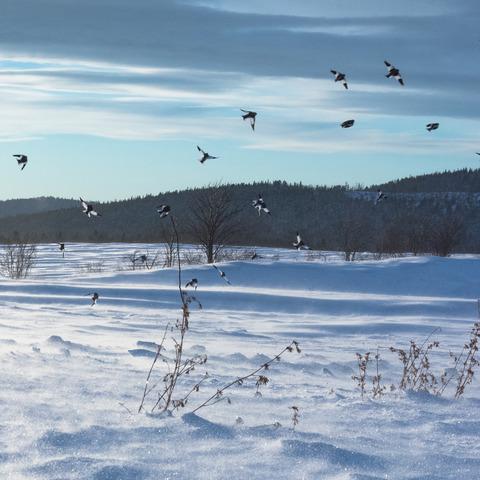当前位置:
X-MOL 学术
›
Funct. Ecol.
›
论文详情
Our official English website, www.x-mol.net, welcomes your
feedback! (Note: you will need to create a separate account there.)
Coping with the worst of both worlds: Phenotypic adjustments for cold acclimatization benefit northward migration and arrival in the cold in an Arctic-breeding songbird
Functional Ecology ( IF 4.6 ) Pub Date : 2021-03-24 , DOI: 10.1111/1365-2435.13793 Audrey Le Pogam 1, 2 , Ryan S. O’Connor 1, 2 , Oliver P. Love 3 , Magali Petit 1, 2 , Lyette Régimbald 1 , François Vézina 1, 2
中文翻译:

应对两全其美:寒冷适应的表型调整有利于北极繁殖的鸣禽向北迁移和抵达寒冷地区
更新日期:2021-03-24
Functional Ecology ( IF 4.6 ) Pub Date : 2021-03-24 , DOI: 10.1111/1365-2435.13793 Audrey Le Pogam 1, 2 , Ryan S. O’Connor 1, 2 , Oliver P. Love 3 , Magali Petit 1, 2 , Lyette Régimbald 1 , François Vézina 1, 2
Affiliation

|
- Cold acclimatization (phenotypic adjustments to cope with cold conditions) is an imperative requirement for birds living at high latitudes during the cold depths of winter. Despite the significant remodelling of key phenotypic traits and energetic costs associated with elevating cold endurance, winter cold acclimatization can also provide further carryover benefits to subsequent stages in species wintering, migrating and breeding in cold environments (e.g. the Arctic).
- We tested this beneficial carryover hypothesis using outdoor captive Arctic-breeding snow buntings Plectrophenax nivalis, a cold specialist known for its impressive wintering thermogenic capabilities. We compared changes in phenotypic traits supporting cold acclimatization—body composition (body, fat, lean mass, pectoral muscle thickness), oxygen carrying capacity (haematocrit), thermogenic capacity and endurance (Msum, time to Msum), cold tolerance (Ta at Msum) and maintenance energy expenditure (BMR)—between the wintering, migratory and arrival/summer stages.
- Body mass (+31%), fat mass (+226%) and BMR (+13%) increased relative to the winter phenotype, likely to support the added costs of migration—that is the migratory upregulation hypothesis. In contrast, lean mass, pectoral muscle thickness, haematocrit and thermogenic capacity remained high and stable at winter level across stages in support of the thermal carryover hypothesis. The maintenance of these traits likely offers spare capacity for unpredictable cold environments expected during migration and breeding in the Arctic.
- Our results thus suggest that birds can extend the long-term advantages of winter phenotypic adjustments through additional benefits to thermogenic capacity during subsequent life-history stages. These benefits likely make it possible for Arctic-breeding birds to maximize success across diverse life-history stages in the face of extreme cold conditions.
中文翻译:

应对两全其美:寒冷适应的表型调整有利于北极繁殖的鸣禽向北迁移和抵达寒冷地区
- 寒冷的驯化(表型调整以应对寒冷条件)是在寒冷的冬季生活在高纬度地区的鸟类的必要要求。尽管关键表型特征的显着重塑和与提高耐寒性相关的能量成本,冬季寒冷驯化还可以为物种在寒冷环境(例如北极)中越冬、迁徙和繁殖的后续阶段提供进一步的结转益处。
- 我们使用户外圈养北极繁殖雪鹀Plectrophenax nivalis测试了这一有益的结转假设,这是一种以其令人印象深刻的越冬产热能力而闻名的寒冷专家。我们比较了支持寒冷适应的表型特征的变化——身体成分(身体、脂肪、瘦体重、胸肌厚度)、携氧能力(血细胞比容)、产热能力和耐力(M sum,达到M sum 的时间)、耐寒性(T a在M sum ) 和维持能量消耗 (BMR)——在越冬、迁徙和到达/夏季阶段之间。
- 体重 (+31%)、脂肪量 (+226%) 和 BMR (+13%) 相对于冬季表型增加,可能支持迁移的额外成本——这就是迁移上调假设。相比之下,瘦体重、胸肌厚度、血细胞比容和产热能力在冬季水平的各个阶段保持高和稳定,以支持热量转移假设。保持这些特性可能为北极迁徙和繁殖期间预期的不可预测的寒冷环境提供备用容量。
- 因此,我们的结果表明,鸟类可以通过在随后的生命历史阶段对产热能力的额外好处来扩展冬季表型调整的长期优势。这些好处可能使北极繁殖鸟类在面对极端寒冷条件时在不同的生命历史阶段取得最大的成功。











































 京公网安备 11010802027423号
京公网安备 11010802027423号